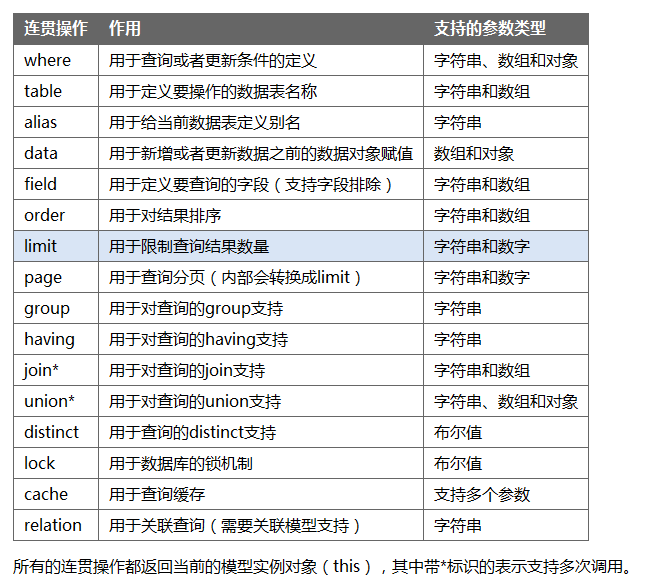本文實例講述了thinkPHP數據庫增刪改查操作方法。分享給大家供大家參考,具體如下:
thinkphp對數據庫增刪改查進行了封裝操作,使得使用更加方便,但是不一定靈活。
可以用封裝的用,需要寫sql,可以執行sql。
1.原始的
$Model = new Model(); // 實例化一個model對象 沒有對應任何數據表
$insert_sql = "INSERT INTO sh_wxuser_collection (user_id,store_id,good_id,addtime) VALUES('".$user_id."','".$store_id."','".$good_id."','".$addtime."');";
$Model - >query($insert_sql);
2.針對表實例化的,這裡的表原名是sh_wxuser_collection。sh是前綴。
$model = M('wxuser_collection'); //自動省去sh
$insert_sql = "INSERT INTO __TABLE__ (user_id,store_id,good_id,addtime) VALUES('".$user_id."','".$store_id."','".$good_id."','".$addtime."');";
$model - >query($insert_sql);
另一種寫法,_可以寫成大寫,它會自動轉化成_
$model = M('WxuserCollection'); //自動省去sh
$insert_sql = "INSERT INTO __TABLE__ (user_id,store_id,good_id,addtime) VALUES('".$user_id."','".$store_id."','".$good_id."','".$addtime."');";
$model - >query($insert_sql);
3. 封裝的add語句
$model = M('WxuserCollection');
$data = array('user_id' = >$user_id, 'store_id' = >$store_id, 'good_id' = >$good_id, 'addtime' = >$addtime);
$model - >data($data) - >add();
4.封裝的修改edit語句
$model = M('WxuserCollection');
$data = array('user_id' = >$user_id, 'store_id' = >$store_id, 'good_id' = >$good_id, 'addtime' = >$addtime);
$model - >data($data) - >where('id=3') - >save();
確實挺方便的,但是方便之余,別忘了原始的sql,原汁原味的sql,才最有意思。
5.find()
$model = M('WxuserCollection');
$res1 = $model - >find(1);
$res2 = $model - >find(2);
$res3 = $model - >where('good_id=1105 AND store_id = 1 AND user_id = 20') - >find();
find獲取一條數據,find(1)獲取id為1的數據,find(2)獲取id為2的數據。最後一個是獲取條件為where的中的第一條數據。
5.select()
$model = M('WxuserCollection');
$res = $model - >where('good_id=1105 AND store_id = 1 AND user_id = 20') - >field('id,good_id as good') - >select();
獲取所有數據。這裡的好處就是,不用考慮sql語句的順序了,隨心所欲調用函數就可以了。
6.delete()
$model = M('WxuserCollection');
$res = $model - >where('id=1') - >delete(); // 成功返回1 失敗返回0
根據條件進行刪除操作

7.field()
$model = M('WxuserCollection');
$res = $model - >field('id,good_id as good') - >select();
$res = $model - >field(array('id', 'good_id' = >'good')) - >select();
$res = $model - >field('id', true) - >select();
字符串,數組兩種方式,第三個是表示獲取處理id之外的所有字段。
8.order()
$model = M('WxuserCollection');
$res = $model - >order('id desc') - >select();
$res = $model - >order('id asc') - >select();
$res = $model - >order(array('id' = >'desc')) - >select();
$res = $model - >order(array('id')) - >select();
字符串,數組兩種方式,默認asc。
9.join()
$Model->join(' work ON artist.id = work.artist_id')->join('card ON artist.card_id = card.id')->select();
$Model->join('RIGHT JOIN work ON artist.id = work.artist_id')->select();
$Model->join(array(' work ON artist.id = work.artist_id','card ON artist.card_id = card.id'))->select();
默認采用LEFT JOIN 方式,如果需要用其他的JOIN方式,可以改成第二種,
如果join方法的參數用數組的話,只能使用一次join方法,並且不能和字符串方式混合使用。
10.setInc()
$User = M("User"); // 實例化User對象
$User->where('id=5')->setInc('score',3); // 用戶的積分加3
$User->where('id=5')->setInc('score'); // 用戶的積分加1
$User->where('id=5')->setDec('score',5); // 用戶的積分減5
$User->where('id=5')->setDec('score'); // 用戶的積分減1
11.getField()
獲取某個字段值
$User = M("User"); // 實例化User對象
// 獲取ID為3的用戶的昵稱
$nickname = $User->where('id=3')->getField('nickname');
返回的nickname是一個字符串結果。也就是說,即使有滿足條件的多個字段,也只會返回一個結果。
獲取某個字段列
如果希望返回符合要求的字段列(多個結果),可以使用:
$User = M("User"); // 實例化User對象
// 獲取status為1的用戶的昵稱列表
$nickname = $User->where('status=1')->getField('nickname',true);
第二個參數傳入了true,返回的nickname則是一個數組,包含了所有滿足條件的昵稱列表。
如果需要限制返回結果數量,可以使用:
$nickname = $User->where('status=1')->getField('nickname',8);
獲取2個字段列表
$User = M("User"); // 實例化User對象
// 獲取status為1的用戶的昵稱列表
$nickname = $User->where('status=1')->getField('id,nickname');
如果getField方法傳入多個字段名稱的話,默認返回一個關聯數組,以第一個字段的值為索引(所以第一個字段要盡量選擇不會重復的)。
獲取多個字段列表
$result = $User->where('status=1')->getField('id,account,nickname');
如果傳入了2個以上的字段名,則返回一個二維數組(類似select方法的返回值,區別在於索引是二維數組的鍵名是第一個字段的值)
綜合使用案例
$where = array('a.store_id' => $this->store_id, 'a.user_id' => $this->user_id);
$collects = $this->collectModel->table("sh_wxuser_collection a")->field(array('b.name','b.price','b.oprice','b.logoimg','a.goods_id'))->limit($start, $offset)->order('a.addtime DESC')->where($where)->join(' sh_goods b ON a.goods_id = b.id')->select();// 獲取當前頁的記錄
echo M()->getLastSql(); // 調試sql語句用
$count = $this->collectModel->table("sh_wxuser_collection a")->where($where)->count(); // 獲取總的記錄數
這裡由於結合了兩張表,所以用到了table方法,重新定義表名,相應的條件和參數都要加上前綴。a. 或者b.
其中field字段要麼是一個字符串,要麼是數組。
field('b.name', 'b.price', 'b.oprice', 'b.logoimg', 'a.goods_id') // 錯誤
我之前就這麼寫,問題大大的。
使用框架,就不能靈活的寫sql了。不過對sql有一個深刻的認識,也有利於靈活的使用好框架。
用於調試sql語句的方法。
echo M()->getLastSql();
很方便。
更多關於thinkPHP相關內容感興趣的讀者可查看本站專題:《ThinkPHP入門教程》、《thinkPHP模板操作技巧總結》、《ThinkPHP常用方法總結》、《codeigniter入門教程》、《CI(CodeIgniter)框架進階教程》、《Zend FrameWork框架入門教程》、《smarty模板入門基礎教程》及《PHP模板技術總結》。
希望本文所述對大家基於ThinkPHP框架的PHP程序設計有所幫助。